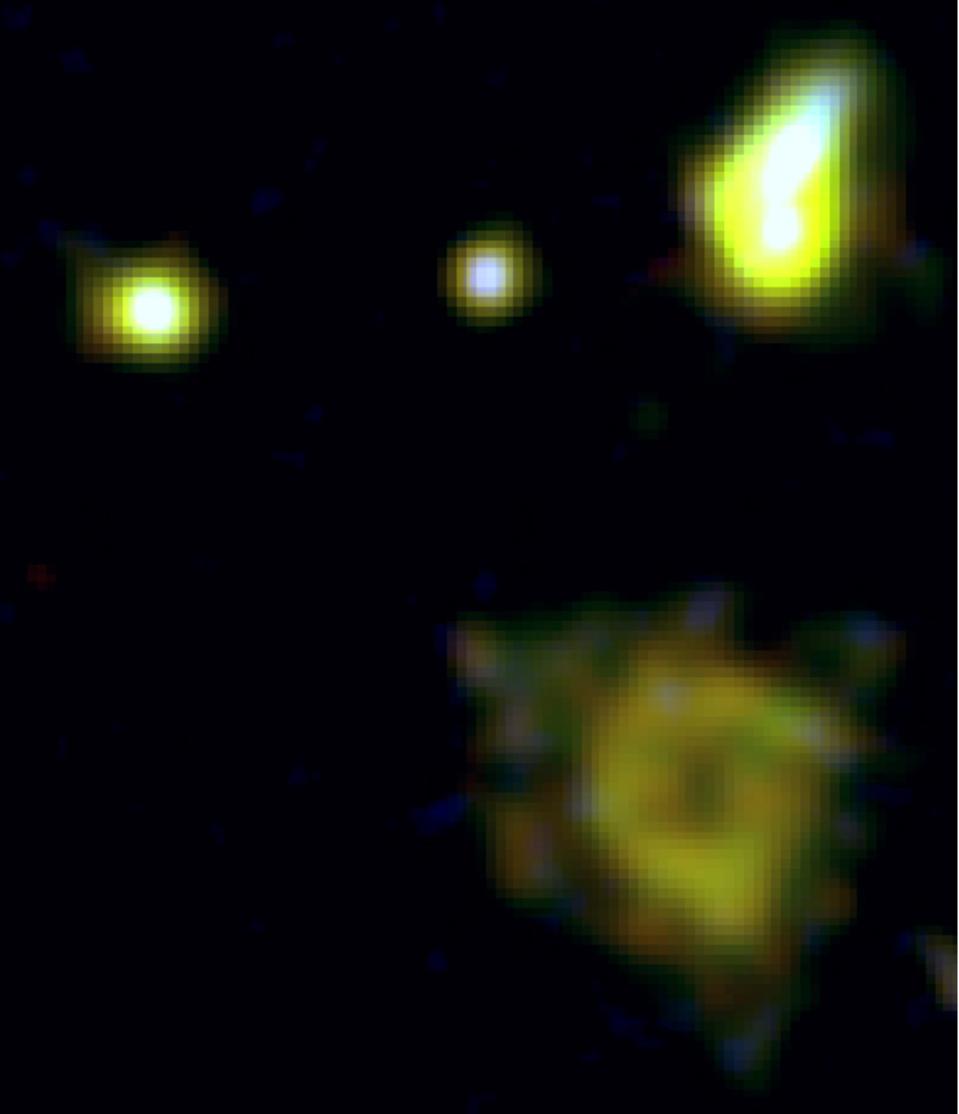Science
Excited Scientists Find ‘Cosmic Ring Of Fire’ Galaxy By Peering 11 Billion Light-Years Back In Time – Forbes

An artist’s impression of the ring galaxy.
James Josephides, Swinburne Astronomy Productions
An Australian-led team of astronomers has unearthed a previously unknown type of galaxy just three billion years after the Big Bang. Variously described as both a “cosmic ring of fire” and a “titanic donut,” the finding could change what we know about how the first galaxies formed.
Announced today in the journal Nature Astronomy, this “collisional ring galaxy”—named R5519—is 10. billion light-years distant and the first of its kind found in the early Universe.
“It is a very curious object that we’ve never seen before,” said lead researcher Dr. Tiantian Yuan, from the Centre for Astrophysics and Supercomputing at Swinburne University of Technology, and the ARC Centre of Excellence for All Sky Astrophysics in 3 Dimensions (ASTRO 3D). “It looks strange and familiar at the same time.”
The publishing of Dr. Yuan’s paper, “A giant galaxy in the young Universe with a massive ring” was accompanied by an incredible video put together by Swinburne University’s astro-animator James Josephides.
Where is R5519?
R5519 is 10.8 billion light-years distant. It was imaged as it existed 11 billion years ago. Does that make it like “looking back in time?” Yes—all astronomy is looking back in time because the light that enters your eyes when stargazing/or a telescope has traveled vast distances through space at light-speed to reach us. Even sunlight is 8 minutes 20 seconds old.
The Big Bang took place around 13.8 billion years ago; R5519 was imaged just three billion light years later.
How big is R5519?
Supermassive. The hole in R5519’s “cosmic ring” has a diameter is two billion times that of the Earth-Sun distance, which astronomers call an astronomical unit (au), though the galaxy itself has a similar mass to our Milky Way.
R5519 is also three million times bigger than the diameter of the supermassive black hole in the galaxy M87, which was the first ever to be directly imaged last year.
Why is R5519 such an incredible discovery?
This giant galaxy with a massive hole in the middle is a super-rare type of galaxy—a “collisional ring galaxy”—that could shake-up theories about how the earliest galaxies formed after the Big Bang, and how galaxies evolve. “It is making stars at a rate 50 times greater than the Milky Way,” said Dr. Yuan. “Most of that activity is taking place on its ring—so it truly is a ring of fire.”
How was R5519 discovered?
Working alongside colleagues from Australia, US, Canada, Belgium and Denmark, Dr. Yuan used spectroscopic data gathered by the W. M. Keck Observatory in Hawaii and images recorded by NASA’s Hubble Space Telescope to identify R5519’s unusual structure.


A composite image of the ring galaxy R5519 compiled from single-colour images taken by the Hubble … [+]
Tiantian Yuan/Hubble Space Telescope
Why is R5519 such an important discovery?
R5519 is the first known “collisional ring galaxy” ever found in the early Universe, and it’s likely the result of a violent encounter with other galaxies. Its discovery has implications for understanding how spiral galaxies like our own Milky Way formed.
That’s because ring galaxies like R5519 are very rare in the local Universe. In fact, they account for a mere 0.01% of galaxies, and are formed by head-on collisions. This paper suggests that massive collisional rings are as rare 11.8 billion years ago as they are today.
“The collisional formation of ring galaxies requires a thin disk to be present in the “victim” galaxy before the collision occurs,” said co-author Professor Kenneth Freeman from the Australian National University. “The thin disk is the defining component of spiral galaxies: before it assembled, the galaxies were in a disorderly state, not yet recognisable as spiral galaxies.”


An artist’s impression of the ring galaxy.
James Josephides, Swinburne Astronomy Productions
“In the case of this ring galaxy, we are looking back into the early Universe by 11 billion years, into a time when thin disks were only just assembling,” said Freeman. “This discovery is an indication that disk assembly in spiral galaxies occurred over a more extended period than previously thought.”
For comparison, the thin disk of our Milky Way galaxy began to come together only about nine billion years ago.
Wishing you clear skies and wide eyes.
Science
Giant prehistoric salmon had tusk-like teeth for defence, building nests


|
|
The artwork and publicity materials showcasing a giant salmon that lived five million years ago were ready to go to promote a new exhibit, when the discovery of two fossilized skulls immediately changed what researchers knew about the fish.
Initial fossil discoveries of the 2.7-metre-long salmon in Oregon in the 1970s were incomplete and had led researchers to mistakenly suggest the fish had fang-like teeth.
It was dubbed the “sabre-toothed salmon” and became a kind of mascot for the Museum of Natural and Cultural History at the University of Oregon, says researcher Edward Davis.
But then came discovery of two skulls in 2014.
Davis, a member of the team that found the skulls, says it wasn’t until they got back to the lab that he realized the significance of the discovery that has led to the renaming of the fish in a new, peer-reviewed study.
“There were these two skulls staring at me with sideways teeth,” says Davis, an associate professor in the department of earth sciences at the university.
In that position, the tusk-like teeth could not have been used for biting, he says.
“That was definitely a surprising moment,” says Davis, who serves as director of the Condon Fossil Collection at the university’s Museum of Natural and Cultural History.
“I realized that all of the artwork and all of the publicity materials and bumper stickers and buttons and T-shirts we had just made two months prior, for the new exhibit, were all out of date,” he says with a laugh.
Davis is co-author of the new study in the journal PLOS One, which renames the giant fish the “spike-toothed salmon.”
It says the salmon used the tusk-like spikes for building nests to spawn, and as defence mechanisms against predators and other salmon.
The salmon lived about five million years ago at a time when Earth was transitioning from warmer to relatively cooler conditions, Davis says.
It’s hard to know exactly why the relatives of today’s sockeye went extinct, but Davis says the cooler conditions would have affected the productivity of the Pacific Ocean and the amount of rain feeding rivers that served as their spawning areas.
Another co-author, Brian Sidlauskas, says a fish the size of the spike-toothed salmon must have been targeted by predators such as killer whales or sharks.
“I like to think … it’s almost like a sledgehammer, these salmon swinging their head back and forth in order to fend off things that might want to feast on them,” he says.
Sidlauskas says analysis by the lead author of the paper, Kerin Claeson, found both male and female salmon had the “multi-functional” spike-tooth feature.
“That’s part of our reason for hypothesizing that this tooth is multi-functional … It could easily be for digging out nests,” he says.
“Think about how big the (nest) would have to be for an animal of this size, and then carving it out in what’s probably pretty shallow water; and so having an extra digging tool attached to your head could be really useful.”
Sidlauskas says the giant salmon help researchers understand the boundaries of what’s possible with the evolution of salmon, but they also capture the human imagination and a sense of wonder about what’s possible on Earth.
“I think it helps us value a little more what we do still have, or I hope that it does. That animal is no longer with us, but it is a product of the same biosphere that sustains us.”
This report by The Canadian Press was first published April 24, 2024.
Brenna Owen, The Canadian Press





Science
Giant prehistoric salmon had tusk-like spikes used for defence, building nests: study


|
|
A new paper says a giant salmon that lived five million years ago in the coastal waters of the Pacific Northwest used tusk-like spikes as defense mechanisms and for building nests to spawn.
The initial fossil discoveries of the 2.7-metre-long salmon in Oregon in the 1970s were incomplete and led researchers to suggest the fish had fang-like teeth.
The now-extinct fish was dubbed the “saber-tooth salmon,” but the study published in the peer-reviewed journal PLOS One today renames it the “spike-toothed salmon” and says both males and females possessed the “multifunctional” feature.
Study co-author Edward Davis says the revelation about the tusk-like teeth came after the discovery of fossilized skulls at a site in Oregon in 2014.
Davis, an associate professor in the department of earth sciences at the University of Oregon, says he was surprised to see the skulls had “sideways teeth.”
Contrary to the belief since the 1970s, he says the teeth couldn’t have been used for any kind of biting.
“That was definitely a surprising moment,” Davis says of the fossil discovery in 2014. “I realized that all of the artwork and all of the publicity materials … we had just made two months prior, for the new exhibit, were all out of date.”





Science
SpaceX sends 23 Starlink satellites into low-Earth orbit


|
|
April 23 (UPI) — SpaceX launched 23 Starlink satellites into low-Earth orbit Tuesday evening from Space Launch Complex 40 at Cape Canaveral Space Force Station in Florida.
Liftoff occurred at 6:17 EDT with a SpaceX Falcon 9 rocket sending the payload of 23 Starlink satellites into orbit.
The Falcon 9 rocket’s first-stage booster landed on an autonomous drone ship in the Atlantic Ocean after separating from the rocket’s second stage and its payload.
The entire mission was scheduled to take about an hour and 5 minutes to complete from launch to satellite deployment.
The mission was the ninth flight for the first-stage booster that previously completed five Starlink satellite-deployment missions and three other missions.





-



 Health22 hours ago
Health22 hours agoRemnants of bird flu virus found in pasteurized milk, FDA says
-
News18 hours ago
Amid concerns over ‘collateral damage’ Trudeau, Freeland defend capital gains tax change
-
Art22 hours ago
Random: We’re In Awe of Metaphor: ReFantazio’s Box Art
-
Art16 hours ago
The unmissable events taking place during London’s Digital Art Week
-



 Politics20 hours ago
Politics20 hours agoHow Michael Cohen and Trump went from friends to foes
-
Tech23 hours ago
Surprise Apple Event Hints at First New iPads in Years
-
Science21 hours ago
NASA hears from Voyager 1, the most distant spacecraft from Earth, after months of quiet
-
Media21 hours ago
Vaughn Palmer: B.C. premier gives social media giants another chance





